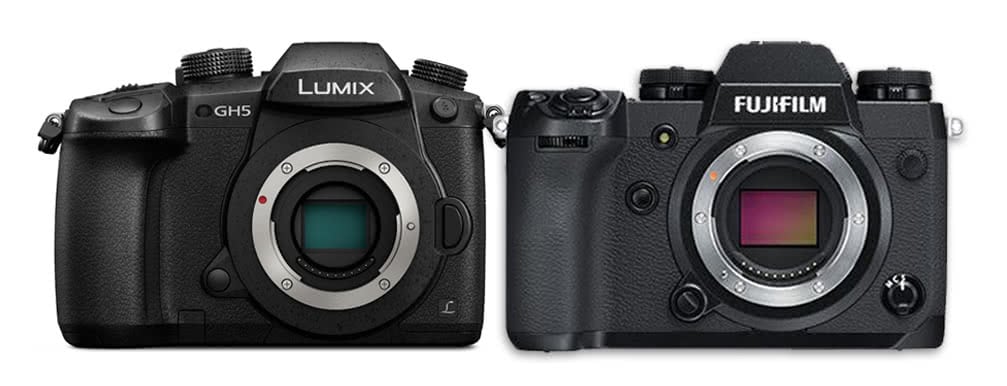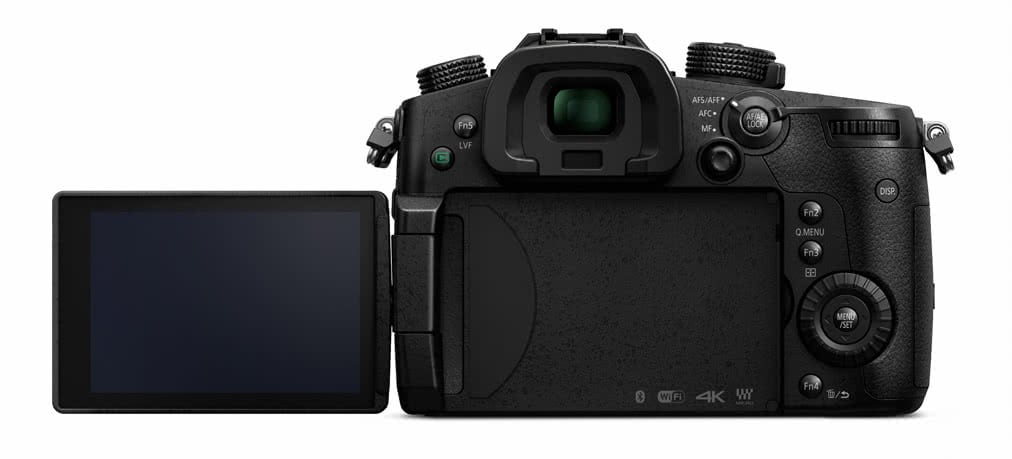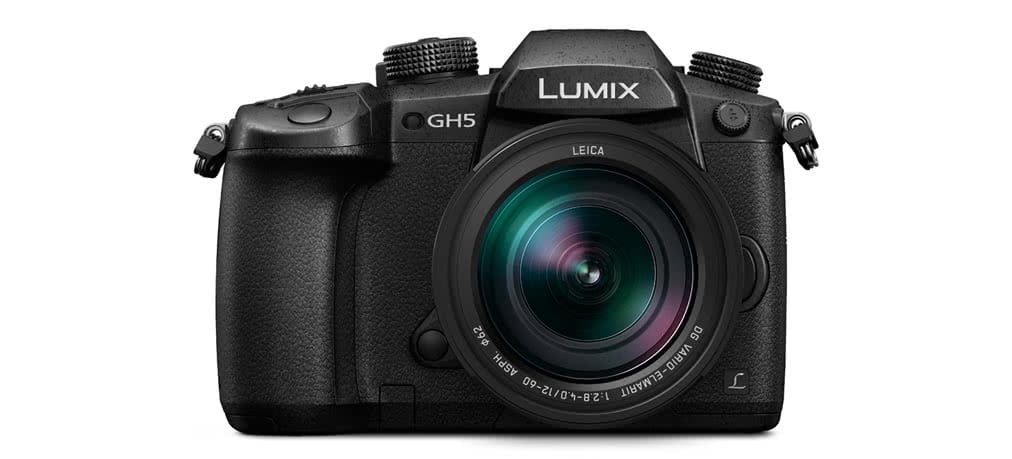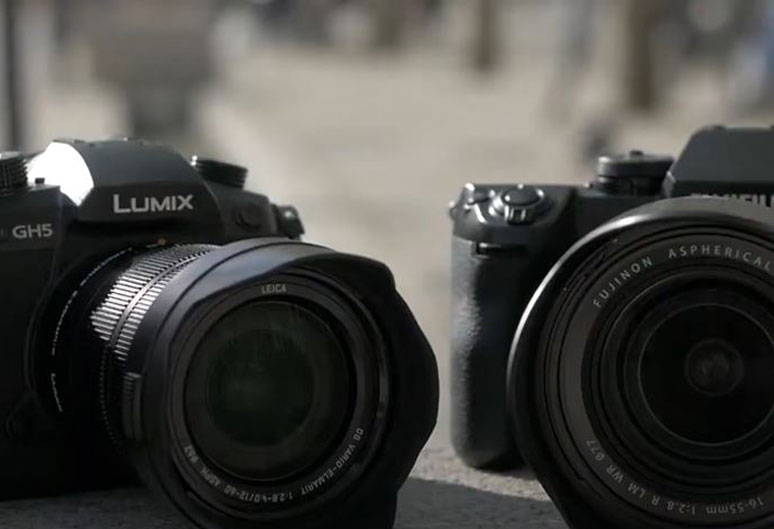The Fujifilm X-H1 is a serious attempt by Fuji to start courting pro video shooters and hybrid photo/video content creators. A large APS-C mirrorless camera capable of shooting 4K at a high bit rate, with colour profiles optimised for video, it merits serious consideration if you’re looking to upgrade your CSC video kit or expand your skill set into this area.
A camera of similar dimensions and spec, one that similar users will be considering, is Panasonic’s LUMIX GH5, successor to the GH4 and considered by some to be the gold standard in terms of mirrorless cameras for vloggers and the like. While there are many cameras available for the videographer, mirrorless and otherwise, these two models are very similar in terms of price, physical size and capabilities. Thus, if one is tempting you, the other merits consideration too.
Which of these cameras is the better buy? We’ll take a closer look for you in our Fujifilm X-H1 vs Panasonic LUMIX GH5 comparison guide…

Build
Externally, these two cameras are very similar. There is barely a hair’s difference in their dimensions, with both measuring around 140mm by 86mm. At 673g, the X-H1 is a little lighter than the 725g Panasonic GH5, but this isn’t really enough to make a significant difference. If one of your main concerns is lightness and portability of your kit, both of these cameras will suit you well.
Elsewhere, both cameras have a full complement of features useful to the videographer, such as rear LCD screens – the Panasonic’s is both a little larger at 3.2 inches, compared to 3 inches on the X-H1, and higher resolution, with 1,620k dots compared to 1,040k. The Panasonic also scores an extra hardware point for coming with a headphone port built into the camera – if you want one on the X-H1, you need to spring for a battery grip. Both cameras also boast dual SD card slots, a very handy feature for memory-hungry video work, and high-resolution electronic viewfinders.

Internally, there are significant differences worth highlighting in the sensors of the two cameras. The GH5 uses a Micro Four Thirds Live MOS sensor with 20MP of resolution, while the XH1 houses a larger APS-C CMOS sensor with 24MP to play with. This gives the XH1 an edge in terms of the image it produces – richer and with more detail than the Panasonic’s.
Video quality
Both cameras are capable of shooting DCI 4K video, which comes at a resolution of 4096 x 2160 pixels. The Panasonic GH5, however, has a significantly better bit rate of 400Mbps compared to 200Mbps on the XH1, which improves the quality of the video captured. Both cameras also have their own bespoke flat Log profile, used to capture the maximum amount of colour data possible in order to make the grade easier when it comes to editing. The Panasonic Log profile is known as V-Log L, while Fuji’s is F-Log. The Panasonic profile is 10-bit (when used in the GH5) while Fuji’s is 8-bit, so that means you’ll get richer colour depth out of the Lumix model.

Shooting experience
You’ll have a great experience shooting with either of these cameras – both are superbly designed by firms with decades of experience in the field. There are some differences worth noting however.
First, let’s look at low-light performance. The Panasonic Lumix GH5 comes sporting an ISO range of 200-25,600, while the Fujifilm XH1 manages 200-12,800. This might lead you to assume the Panasonic will have the edge in low-light shooting, however, the GH5 is not particularly rated in video circles for its low-light performance, with many users agreeing that footage only really stays usable up to about ISO 6400. Thanks in no small part to its larger sensor, the Fujifilm XH1 produces better low-light footage and copes better at high ISO levels. If low-light shooting is a priority for you, this is worth keeping in mind.

(Of course, it is worth mentioning that in this arena, both of these cameras are comprehensively walloped by Sony’s A7S II, the undisputed king of low-light shooting in the mirrorless realm, with a price to match. That’s out of the purview of this particular blog for now, but is worth mentioning.)
If you’re a run-and-gun type of filmmaker you may find yourself wanting to rely on your camera’s autofocus system, and both of these models deliver pretty well on that front. The XH1 has the edge though, with 325 focus points compared to 225 on the GH5, and a hybrid system that makes use of both contrast-detect and phase-detect AF, rather than just phase-detect on the GH5.
Incorporating slow-motion footage into your video work? Both cameras will allow you to do so, however the GH5 will do it better, shooting at a super-slow 180fps, compared to the still-respectable 120fps on the XH1.
Finally, the GH5 has an edge in terms of battery life, shooting for longer than the XH1. Both cameras can take battery grips, which you’ll want for shooting video.
Lenses
The Fujifilm XH1 is of course X-mount, and this gives it access to the full roster of X lenses. Many of these are absolutely gorgeous – tack-sharp, with generous maximum apertures and smooth zooming action in the models that offer that functionality. However, the Micro Four Thirds mount of the GH5 makes it a comprehensive winner here. The user just has so much glass to choose from at first instance, without needing to get any adapters involved. That’s tough to beat.
Verdict
It’s a tough one, for definite, and the important thing to remember is that both of these cameras are fantastic achievements in technology that will serve you well for your videography needs. For now though, the Panasonic Lumix GH5 has a slight edge thanks to superior video features such as its higher bit rate and better Log profile, as well as the superior lens selection. This, of course, does depend on your situation – if you think you’ll be relying on autofocus and/or shooting a lot in low light, the XH1 may well be your best bet. Feel free to get in touch with us if you’d like to chat about the strengths and weaknesses of these cameras in greater detail – someone on the team will be happy to help!


